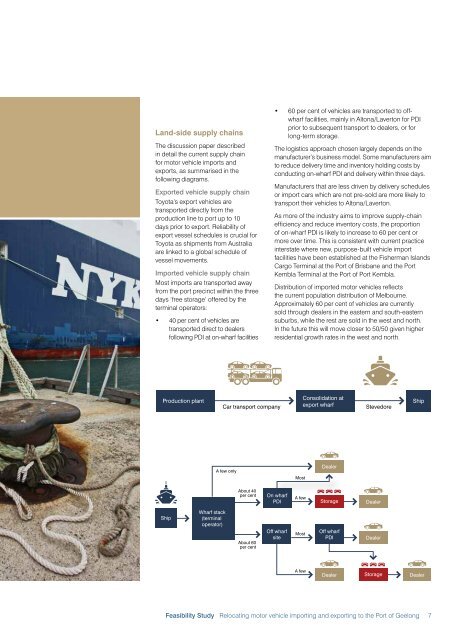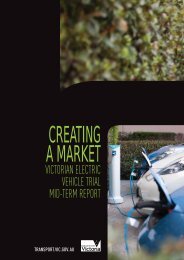Feasibility Study - Department of Transport
Feasibility Study - Department of Transport
Feasibility Study - Department of Transport
Create successful ePaper yourself
Turn your PDF publications into a flip-book with our unique Google optimized e-Paper software.
Land-side supply chains<br />
The discussion paper described<br />
in detail the current supply chain<br />
for motor vehicle imports and<br />
exports, as summarised in the<br />
following diagrams.<br />
Exported vehicle supply chain<br />
Toyota’s export vehicles are<br />
transported directly from the<br />
production line to port up to 10<br />
days prior to export. Reliability <strong>of</strong><br />
export vessel schedules is crucial for<br />
Toyota as shipments from Australia<br />
are linked to a global schedule <strong>of</strong><br />
vessel movements.<br />
Imported vehicle supply chain<br />
Most imports are transported away<br />
from the port precinct within the three<br />
days ‘free storage’ <strong>of</strong>fered by the<br />
terminal operators:<br />
• 40 per cent <strong>of</strong> vehicles are<br />
transported direct to dealers<br />
following PDI at on-wharf facilities<br />
• 60 per cent <strong>of</strong> vehicles are transported to <strong>of</strong>fwharf<br />
facilities, mainly in Altona/Laverton for PDI<br />
prior to subsequent transport to dealers, or for<br />
long-term storage.<br />
The logistics approach chosen largely depends on the<br />
manufacturer’s business model. Some manufacturers aim<br />
to reduce delivery time and inventory holding costs by<br />
conducting on-wharf PDI and delivery within three days.<br />
Manufacturers that are less driven by delivery schedules<br />
or import cars which are not pre-sold are more likely to<br />
transport their vehicles to Altona/Laverton.<br />
As more <strong>of</strong> the industry aims to improve supply-chain<br />
efficiency and reduce inventory costs, the proportion<br />
<strong>of</strong> on-wharf PDI is likely to increase to 60 per cent or<br />
more over time. This is consistent with current practice<br />
interstate where new, purpose-built vehicle import<br />
facilities have been established at the Fisherman Islands<br />
Cargo Terminal at the Port <strong>of</strong> Brisbane and the Port<br />
Kembla Terminal at the Port <strong>of</strong> Port Kembla.<br />
Distribution <strong>of</strong> imported motor vehicles reflects<br />
the current population distribution <strong>of</strong> Melbourne.<br />
Approximately 60 per cent <strong>of</strong> vehicles are currently<br />
sold through dealers in the eastern and south-eastern<br />
suburbs, while the rest are sold in the west and north.<br />
In the future this will move closer to 50/50 given higher<br />
residential growth rates in the west and north.<br />
Production plant<br />
Car transport company<br />
Consolidation at<br />
export wharf<br />
Stevedore<br />
Ship<br />
A few only<br />
Most<br />
Dealer<br />
About 40<br />
per cent<br />
On wharf<br />
PDI<br />
A few<br />
Storage<br />
Dealer<br />
Ship<br />
Wharf stack<br />
(terminal<br />
operator)<br />
About 60<br />
per cent<br />
Off wharf<br />
site<br />
Most<br />
Off wharf<br />
PDI<br />
Dealer<br />
A few<br />
Dealer<br />
Storage<br />
Dealer<br />
<strong>Feasibility</strong> <strong>Study</strong> Relocating motor vehicle importing and exporting to the Port <strong>of</strong> Geelong 7

















